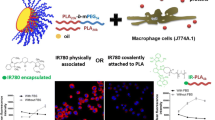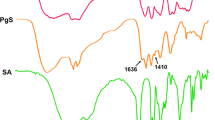Abstract
This work proposed a method for fabricating poly(lactic-co-glycolic acid) (PLGA) nanoparticles (ca. 70 nm) loaded with indocyanine green (ICG) molecules by an antisolvent crystallization method using dimethyl sulfoxide (DMSO) as a good solvent and water as a poor solvent. ICG molecules were loaded to PLGA nanoparticles by mixing PLGA, polyethylenimine, and polyethylene glycol (PEG) in DMSO with polyvinyl alcohol, albumin, and ICG in water. The ICG-loaded PLGA nanoparticle colloid solutions emitted fluorescence even at high ICG concentrations. Not only the tissues of a tumor-bearing mouse but also the tumor could be imaged with an IVIS system by injecting ICG-loaded PLGA nanoparticle colloid solution into the tail vein of the mouse and measuring the emitted fluorescence intensity, though some ICG-loaded PLGA nanoparticles were trapped in tissues such as the liver and spleen due to insufficient PEGylation. Thus, this work showed that ICG-loaded PLGA nanoparticles have potential for cancer imaging.
Graphical abstract













Similar content being viewed by others
Abbreviations
- ICG:
-
Indocyanine green
- PLGA:
-
Poly(lactic-co-glycolic acid)
- AIE:
-
Aggregation-induced emission
- PEI:
-
Polyethylenimine
- DMSO:
-
Dimethyl sulfoxide
- PEG:
-
Polyethylene glycol
- PVA:
-
Polyvinyl alcohol
- BSA:
-
Bovine serum albumin
- TEM:
-
Transmission electron microscopy
- ELS:
-
Electrophoretic light scattering
- UV-VIS-NIR:
-
Ultraviolet-visible-near-infrared extinction spectroscopy
- IVIS:
-
In vivo imaging system
- RE:
-
Radiant efficiency
References
Barzan M, Hajiesmaeilbaigi F (2018) Investigation the concentration effect on the absorption and fluorescence properties of Rhodamine 6G dye. Optik 159:157–161
Li W, Wang J, Tebyetekerwa M, Ding Y, Qiu Z, Yan C, Liu F, Zhang J (2019) Retained fluorescence of aggregation-caused quenched Rhodamine grafted in the hierarchical mesopores of silica MCM-41 at solid-state. Adv Powder Technol 30:2218–2224
Wu H, Wang S, Ding J, Wang R, Zhang Y (2020) Effect of π-conjugation on solid-state fluorescence in highly planar dyes bearing an intramolecular H-bond. Dyes Pigm
Zhao P, Zheng M, Yue C, Luo Z, Gong P, Gao G, Sheng Z, Zheng C, Cai L (2014) Improving drug accumulation and photothermal efficacy in tumor depending on size of ICG loaded lipid-polymer nanoparticles. Biomater 35:6037–6046
Song X, Wu H, Li S, Wang Y, Ma X, Tan M (2015) Ultrasmall chitosan-genipin nanocarriers fabricated from reverse microemulsion process for tumor photothermal therapy in mice. Biomacromol 16:2080–2090
Wang Q, Ding X, Wang Y, Du Q, Xu T, Du B, Yao H (2018) The ratiometric fluorescence nanoparticle based on SiRB for pH detection of tumor. Eur J Pharm Sci 118:32–39
Yu S, Xu D, Wan Q, Liu M, Tian J, Huang Q, Deng F, Wen Y, Zhang X, Wei Y (2017) Construction of biodegradable and biocompatible AIE-active fluorescent polymeric nanoparticles by Ce(IV)/HNO3 redox polymerization in aqueous solution. Mater Sci Eng C 78:191–197
Xu D, Zeng S, Liu M, Chen J, Huang H, Deng F, Tian J, Wen Y, Zhang X, Wei Y (2019) Preparation of PEGylated and biodegradable fluorescent organic nanoparticles with aggregation-induced emission characteristics through direct ring-opening polymerization. J Taiwan Inst Chem Eng 95:234–240
Liu Z, Li X, Xiu B, Duan C, Li J, Zhang X, Yang X, Dai W, Johnson H, Zhang H, Feng X (2016) A novel and simple preparative method for uniform-sized PLGA microspheres: preliminary application in antitubercular drug delivery. Colloids Surf B 145:679–687
Nguyen JMV, Hogen L, Laframboise S, Bouchard-Fortier G, Ferguson SE, Bernardini MQ, May T (2020) The use of indocyanine green fluorescence angiography to assess anastomotic perfusion following bowel resection in surgery for gynecologic malignancies - a report of 100 consecutive anastomoses. Gynecol Oncol. https://doi.org/10.1016/j.ygyno.2020.05.008
Lin J, Lin LS, Chen DR, Lin KJ, Wang YF, Chang YJ (2020) Indocyanine green fluorescence method for sentinel lymph node biopsy in breast cancer. Asian J Surg. https://doi.org/10.1016/j.asjsur.2020.02.003
Carl B, Bopp M, Benescu A, Saß B, Nimsky C (2020) Indocyanine green angiography visualized by augmented reality in aneurysm surgery. World Neurosurg. https://doi.org/10.1016/j.wneu.2020.06.219
Kobayashi Y, Maceira VS, Liz-Marzán LM (2001) Deposition of silver nanoparticles on silica spheres by pretreatment steps in electroless plating. Chem Mater 13:1630–1633
Kobayashi Y, Tadaki Y, Nagao D, Konno M (2005) Deposition of gold nanoparticles on silica spheres by electroless metal plating technique. J Colloid Interface Sci 283:601–604
Kobayashi Y, Imai J, Nagao D, Takeda M, Ohuchi N, Kasuya A, Konno M (2007) Preparation of multilayered silica-Gd-silica core-shell particles and their magnetic resonance images. Colloids Surf A 308:14–19
Kobayashi Y, Imai J, Nagao D, Konno M (2008) Fabrication of Eu-coated silica particles by homogeneous precipitation method. Colloids Surf A 326:109–114
Kobayashi Y, Imai J, Nagao D, Konno M (2009) Fabrication of monodispersed, multilayered ailica-Y:Eu-silica core-shell particles and their photonic crystals. J Chem Eng Jpn 42:47–50
Kobayashi Y, Morimoto H, Nakagawa T, Kubota Y, Gonda K, Ohuchi N (2013) Preparation of Gd complex-immobilized silica particles and their application to MRI. ISRN Nanotechnol 2013:908614
Kobayashi Y, Shibuya K, Nakagawa T, Kubota Y, Gonda K, Ohuchi N (2015) Direct immobilization of gadolinium complex on silica particles and their MRI properties. e-J Surf Sci Nanotechnol 13:42–46
Shau MD, Shih MF, Lin CC, Chuang IC, Hung WC, Hennink WE, Cherng JY (2012) A one-step process in preparation of cationic nanoparticles with poly(lactide-co-glycolide)-containing polyethylenimine gives efficient gene delivery. Eur J Pharm Sci 46:522–529
Baik MH, Lee SY (2010) Colloidal stability of bentonite clay considering surface charge properties as a function of pH and ionic strength. J Indust Eng Chem 16:837–841
Shrestha S, Wang B, Dutta P (2020) Nanoparticle processing: understanding and controlling aggregation. Adv Colloid Interface Sci 279:102162
Wang K, Zhang X, Zhang X, Yang B, Li Z, Zhang Q, Huang Z, Wei Y (2015) One-pot preparation of cross-linked amphiphilic fluorescent polymer based on aggregation induced emission dyes. Colloids Surf B 126:273–279
Lee SJ, Kumar S, Choi JW, Lee JS (2020) Coloration of colloidal polymer particles through selective extraction of Mie backscattering for cation-responsible colorimetric sensors. J Colloid Interface Sci 560:894–901
Capozza M, Blasi F, Valbusa G, Oliva P, Cabella C, Buonsanti F, Cordaro A, Pizzuto L, Maiocchi A, Poggi L (2018) Photoacoustic imaging of integrin-overexpressing tumors using a novel ICG based contrast agent in mice. Photoacoust 11:36–45
Zhang H, Zhang X, Zhu X, Chen J, Chen Q, Zhang H, Hou L, Zhang Z (2018) NIR light-induced tumor phototherapy using photo-stable ICG delivery system based on inorganic hybrid. Nanomed-Nanotechnol Biol Med 14:73–84
Desmettre T, Devoisselle JM, Mordon S (2000) Fluorescence properties and metabolic features of indocyanine green (ICG) as related to angiography. Surv Ophthalmol 45:15–27
Park HS, Cho MY, Noh YW, Hong KS, Lim YT (2017) Contrast agents based on switchable near-infrared fluorescent nanoprobes for highly sensitive optical imaging. Dyes Pigm 136:583–589
Quan B, Choi K, Kim YH, Kang KW, Chung DS (2012) Near infrared dye indocyanine green doped silica nanoparticles for biological imaging. Talanta 99:387–393
Yan F, Wu H, Liu H, Deng Z, Liu H, Duan W, Liu X, Zheng H (2016) Molecular imaging-guided photothermal/photodynamic therapy against tumor by iRGD-modified indocyanine green nanoparticles. J Control Rel 224:17–228
Nguyen TNT, Nguyen-Tran DH, Bach LG, Truong THD, Le NTT, Nguyen DH (2019) Surface PEGylation of hollow mesoporous silica nanoparticles via aminated intermediate”. Prog Nat Sci Mater Int 29:612–616
Demirel E, Karaca E, Durmaz YY (2020) Effective PEGylation method to improve biocompatibility of graphene Derivatives. Eur Polym J 124:109504
Ribeiro TP, Monteiro FJ, Laranjeira MS (2020) PEGylation of iron doped hydroxyapatite nanoparticles for increased applicability as MRI contrast agents and as drug vehicles: a study on thrombogenicity, cytocompatibility and drug loading. Eur Polym J 137:109934
Author information
Authors and Affiliations
Contributions
MT synthesized indocyanine green-loaded poly(lactic-co-glycolic acid) nanoparticles, investigated their morphology, and wrote the first draft. TI, MT, and CK performed the IVIS imaging. NY, KN, KG, and YK intensively discussed the results of investigation of particle morphology and IVIS imaging and completed the manuscript.
Corresponding author
Rights and permissions
About this article
Cite this article
Tayama, M., Inose, T., Yamauchi, N. et al. Fabrication and fluorescence imaging properties of indocyanine green-loaded poly(lactic-co-glycolic acid) nanoparticles. Colloid Polym Sci 299, 1271–1283 (2021). https://doi.org/10.1007/s00396-021-04844-3
Received:
Revised:
Accepted:
Published:
Issue Date:
DOI: https://doi.org/10.1007/s00396-021-04844-3




